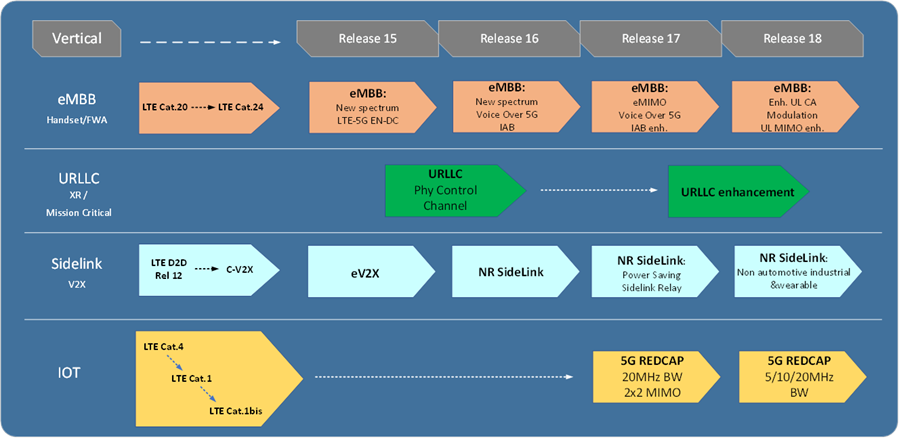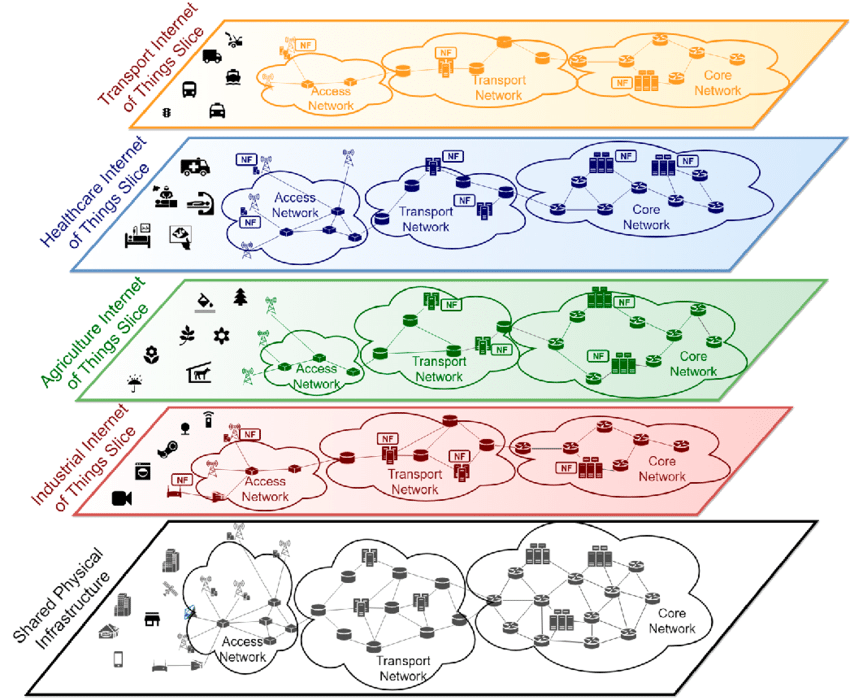5G’s real promise comes not from mobile phones, but from industrial and business applications where network operators hope to recover the huge investments they’ve made in 5G network infrastructure and spectrum. 5G for IoT extends the mobile network to billions of IoT nodes. That’s a much more ambitious goal than consumer use because 5G must adapt to the diverse nature of endpoints. These endpoint “things” range from mobile phones and fixed wireless networks that need lots of bandwidth and “frequently on” operation to sensor modules that infrequently transmit or receive small packets of data. Many IoT product needs will, however, fall somewhere in-between. They don’t need high-speed 5G performance, but they have much tighter power/cost requirements than phones or fixed terminals and aggressively target latency for a wide range of use cases. That’s where the new 5G RedCap standard comes into play.
The 3GPP broadband standard specifies four distinct (but related) vectors (Figure 1). The first and primary vector, enhanced mobile broadband (eMBB), specified in Release 15, targets consumer handsets and Fixed Wireless Access (FWA). A second vector, specified in Release 16, covers ultra-reliable, low-latency communication (URLLC). This vector targets time-critical edge computing and supports future AR/VR devices. A third vector is Sidelink. Primarily targeted for automotive V2X, Sidelink is expected to be supported in non-automotive use cases beginning with Release 18, including industrial and IoT (where it will converge with RedCap). The fourth vector is 5G for IoT. LTE, in particular LTE Cat-1, partially serves these applications but is now being fully embraced by 5G, with introduction of 5G RedCap in Release 17. Further improvements and optimizations should come in Release 18.
 Figure 1. 5G consists of four distinct but related vectors
Figure 1. 5G consists of four distinct but related vectors
What is RedCap?
Reduced Capability (RedCap) brings the benefits of 5G, especially in the network with performance on par with previous generation LTE, at significantly lower latency, targeting the missing performance grade between baseline full performance 5G devices supporting eMBB and URLLC (with peak rates in the range of Gbps), and narrow bandwidth massive machine-type communication (mMTC, supporting 1 Mb/sec). RedCap devices will support around 85 Mb/sec, a performance grade that can serve a wide range of industrial and IoT use cases.
Supporting IoT in 5G networks allows for cost effective greenfield deployments — no need to support three networks: 5G, LTE, and eMTC/NB-IoT). 5G’s focus on reduced-capability use cases coincides with the rapid rise in private networks. RedCap and private networks open the field for new cost-effective deployments addressing enterprise and industrial use cases. The 5G network also provides more spectrum options, including unlicensed spectrum. RedCap will also support operation in millimeter wave, where the limited coverage becomes advantageous in spectral re-use. 5G networks also offer increased coverage in sub-6 GHz through beamforming, where the onset of complexity lies on the infrastructure side, keeping the user-side equipment lean, compact, and power efficient. 5G also allows improved device positioning, with Release 17 promising centimeter-level positioning accuracy, which will further benefit industrial use cases.
5G networks provide superior network management over LTE, supporting guaranteed quality of service (QoS). A common network infrastructure can offer this enhanced management through software-based network slicing, security, and mobile edge computing (MEC) options. Slicing (Figure 2) can provide tiered levels of QoS without need for adding more hardware, reusing the same network infrastructure to support highly fragmented industrial use cases. MEC moves traditional cloud compute functions into the network to reduce congestion and improve cost and latency. For example, security and AI functions can be provided in local gateways. Private cellular networks are another possible application, where ultra-performance may be less important than the advantages of enhanced security, improved availability, and function tuned to need of that network.
 Figure 2. Network slices let private networks and applications run in configurations defined for a particular use.
Figure 2. Network slices let private networks and applications run in configurations defined for a particular use.
What kind of IoT applications could benefit from these enhancements?
- Industrial sensors in factories and the grid (pressure, CO2, humidity, motion, temperature sensors and many more);
- Surveillance monitors;
- Wearables (including emerging XR devices for the glasses form factor), automotive telematics;
- e-health and medical monitoring devices.
These applications have some level of criticality in information they share or to which they must respond. Yet, these applications are very sensitive to cost and power constraints. RedCap aims to help IoT product builders find the right balance.
One concrete example is for automotive telemetry. We usually think of cellular V2X applications in vehicles for communication with other vehicles or infrastructure for safety, navigation, and traffic management. These require dedicated support for Sidelink communications and require similar performance as with 5G Redcap. Telemetry is a quite different application. The telematics box (T-box) is an established piece of electronics in modern cars, responsible for remotely connecting vehicle functions and more. These systems use cellular technology, and emerging systems are starting to use 5G. Here, telematics can handle over the-air updates, collect and communicate vehicle statistics, and schedule service when detecting problems. Telematics communication link volume could exceed that of V2X, and it is suited for the Redcap performance envelope.
Design for RedCap?
RedCap isn’t fully ratified yet; ratification is expected around the middle of 2022. We expect initial RedCap deployments in 2024 to 2025, with volume ramp-up not before 2026.
Changing a communications method once RedCap comes online could be expensive both in schedule and in development cost. I’d recommend that you build your product with a communication system that can operate over LTE but can easily switch to RedCap through a software update or simple re-spin. Many product builders are eager to find such a solution to communications issues. A communications link will help them put products on shelves right away, with a smooth migration to 5G RedCap when the standard matures. Table 1 contrasts the three major segments of 5G.
There’s always risk in planning for a next generation without undermining near-term revenue, but that risk can and should be manageable. Because IoT applications require low-cost devices, we expect RedCap implementations to be much more integrated, not only digital baseband and RF portions, but in some cases integration with other complementing communication technologies as well as application-specific SoCs. This will allow optimization of SoCs to specific use cases. It should also bring new vendors and OEMs — who don’t specialize in communications — an option to differentiate their products by integrating RedCap IP into SoCs, similar as they do now for Wi-Fi.
Published on 5G Technology World.

